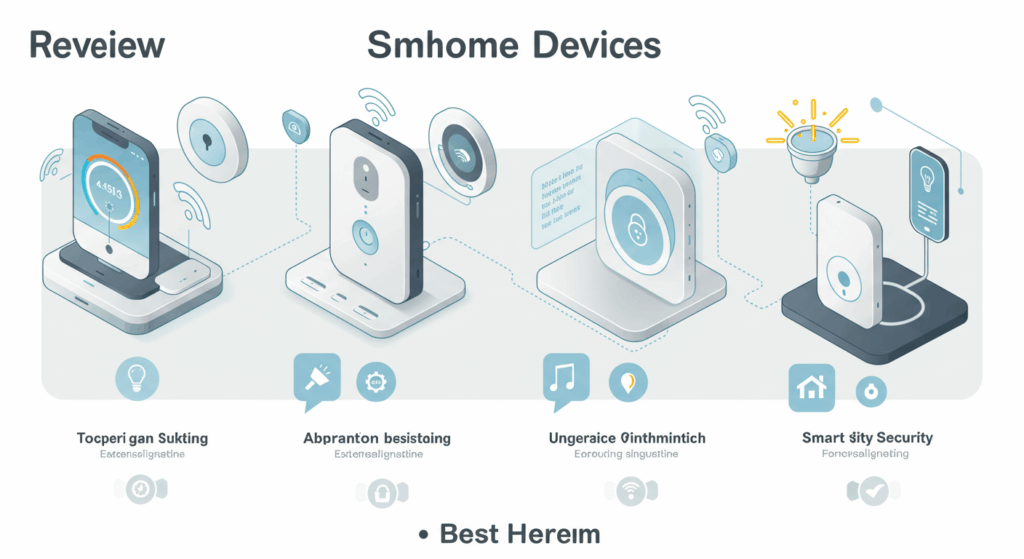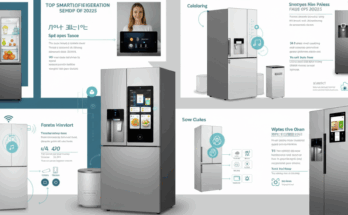In 2025, smart home technology has reached new heights, offering unprecedented convenience, security, and energy efficiency. From voice-controlled hubs to AI-powered appliances, the latest devices are more intuitive, interoperable, and affordable than ever. This comprehensive review explores the best smart home devices of 2025, covering 19 categories, with a focus on functionality, compatibility, and value. Whether you’re a tech novice or a seasoned smart home enthusiast, these top picks will help you transform your living space into a smarter, more connected home.
Why Smart Homes Matter in 2025
Smart home devices are no longer futuristic concepts; they’re practical tools that save time, reduce energy costs, and enhance security. With the rise of the Matter standard, backed by tech giants like Amazon, Google, and Apple, devices from different brands now work together seamlessly, eliminating compatibility issues. Wi-Fi 6 and Thread protocols ensure faster, more reliable connections, while AI-driven features add intelligence to everyday tasks. Whether you’re automating lighting, monitoring security, or optimizing energy use, 2025’s smart home devices are designed to make life easier and more enjoyable.
Top Smart Home Devices of 2025
1. Smart Speakers: Amazon Echo (5th Gen)
The Amazon Echo (5th Gen) is a standout smart speaker, serving as the backbone of many smart homes. Priced at around $100 (often discounted), it combines rich audio with robust smart home hub functionality. Its 3-inch woofer and dual 0.8-inch tweeters deliver room-filling sound, while the built-in Zigbee and Matter hub supports a wide range of devices, from lights to locks. With Wi-Fi 6, a temperature sensor, and adaptive sound, it’s a versatile choice for Alexa users. However, its bass depth is average, and Alexa can struggle with complex queries. Ideal for those seeking an affordable, all-in-one hub.
Pros: Rich audio, versatile hub, fast Wi-Fi, privacy mic switch.
Cons: Limited color options, finicky setup.
Price: ~$100 (Amazon).
2. Smart Displays: Echo Show 8 (3rd Gen)
For those who prefer visual interaction, the Amazon Echo Show 8 (3rd Gen) is the top smart display. Its 8-inch 1080p touchscreen, 5MP camera, and dual 1.6-inch speakers make it perfect for video calls, streaming (Prime, Hulu, Netflix), and managing smart devices. With Zigbee, Matter, and Thread support, it doubles as a smart home hub. The sleek edge-to-edge glass design and spatial audio enhance its appeal, though it lacks native YouTube support (accessible via browser). It’s ideal for kitchens or living rooms.
Pros: Great display, powerful speakers, versatile hub.
Cons: No native YouTube, bulky design.
Price: ~$150 (Amazon).
3. Smart Lighting: Philips Hue White and Color Ambiance Starter Kit
Philips Hue remains a leader in smart lighting, and its 2025 starter kit with Matter support is a top pick. Offering 16 million colors and tunable white light, these bulbs create custom lighting scenes via smartphone or voice assistants (Alexa, Google Assistant, Siri). They connect directly to Wi-Fi, eliminating the need for a hub in smaller setups. While pricey, their vibrant colors and seamless integration justify the cost. Govee’s color-shifting bulbs are a budget-friendly alternative but lack Hue’s brightness.
Pros: Vibrant colors, Matter support, easy setup.
Cons: Expensive, hub needed for larger setups.
Price: ~$130 for starter kit (Amazon).
4. Smart Plugs: TP-Link Kasa Smart Wi-Fi Plug
TP-Link’s Kasa Smart Wi-Fi Plug is the best way to make any appliance smart. Priced at ~$25, it allows voice control (Alexa, Google Assistant) and scheduling for devices like lamps or coffee makers. Its energy-monitoring feature tracks power usage, helping you identify energy hogs. The app is intuitive, and the plug’s compact design doesn’t block adjacent outlets. It’s a cost-effective entry into smart home automation, though it lacks HomeKit support.
Pros: Affordable, energy monitoring, reliable app.
Cons: No HomeKit, limited to 15 amps.
Price: ~$25 (Amazon).

5. Smart Thermostats: Ecobee Smart Thermostat Premium
The Ecobee Smart Thermostat Premium is a top choice for energy-conscious homes. Its 3.5-inch touchscreen, built-in Alexa, and air quality monitor provide health insights and even temperature control. With Wi-Fi 6 and a room sensor, it optimizes heating and cooling based on occupancy. Users report saving hundreds annually by scheduling energy use efficiently. However, its setup is complex, and additional sensors are pricey.
Pros: Alexa integration, energy savings, intuitive app.
Cons: Complex setup, no HomeKit.
Price: ~$250 (Amazon).
6. Smart Security Systems: Ring Alarm Pro
The Ring Alarm Pro is the best all-in-one security system, featuring a built-in Eero Wi-Fi 6 router for seamless connectivity. It offers customizable configurations for doors, windows, and leaks, with add-ons like motion sensors and cameras. While it lacks support for non-Ring ecosystems, its reliability and app simplicity make it a favorite. A Ring Protect subscription unlocks advanced features like video storage.
Pros: Built-in router, customizable, reliable app.
Cons: Subscription for full features, no cross-platform support.
Price: ~$300 for base kit (Amazon).
7. Smart Cameras: Eufy S220 Indoor Cam
The Eufy S220 Indoor Cam delivers vivid 2K video, local and cloud storage, and automatic motion tracking. Compatible with Alexa, Google Assistant, and HomeKit, it’s packed with features typically found in pricier models. Its affordability (~$60) and versatility make it ideal for monitoring pets or indoor spaces. The Furbo 360 Dog/Cat Camera is a fun alternative with treat-tossing and pet-specific notifications.
Pros: High-resolution video, affordable, cross-platform.
Cons: Limited outdoor use, cloud storage fees.
Price: ~$60 (Amazon).
8. Robot Vacuums: Roomba Combo j9+
The Roomba Combo j9+ is the ultimate cleaning robot, combining vacuuming and mopping with advanced home mapping. Its three-stage cleaning system tackles tough dirt, and the iRobot app allows precise room-by-room control. Compatible with Alexa and Google Assistant, it’s pricey but efficient. Budget-friendly options like the Roborock Q5 offer strong suction but fewer features.
Pros: Vacuum and mop, smart navigation, app control.
Cons: High cost, requires floor prep.
Price: ~$1,000 (Amazon).
9. Smart Doorbells: Philips 7000 Series Video Doorbell
The Philips 7000 Series Video Doorbell offers crisp 2K footage, clear audio, and built-in storage, eliminating subscription needs. It supports Alexa, Google Assistant, and HomeKit, with options for wired or wireless installation. Its 180-degree field of view ensures no package goes unnoticed. Arlo’s doorbell is a budget-friendly alternative with similar features.
Pros: No subscription, wide view, cross-platform.
Cons: Wired setup may require professional help.
Price: ~$150 (Amazon).
10. Smart Locks: August Smart Lock Pro
The August Smart Lock Pro uses biometric palm data for keyless entry, offering convenience and security. Compatible with Alexa, Google Assistant, and HomeKit, it integrates seamlessly into smart home ecosystems. Its sleek design and reliable performance make it a top pick, though it’s pricier than traditional locks.
Pros: Biometric entry, cross-platform, easy install.
Cons: Expensive, battery life varies.
Price: ~$200 (Amazon).
Emerging Innovations
Beyond these staples, 2025 introduces futuristic devices like Samsung’s Ballie, an AI-powered robotic companion that manages appliances, acts as a mobile security camera, and projects images. Though not widely available, it hints at the future of smart homes. Similarly, Ring’s indoor drone camera, which autonomously navigates to monitor security threats, could revolutionize home surveillance if released in 2025.
Choosing the Right Ecosystem
Selecting the right platform—Alexa, Google Assistant, or Siri—is crucial. Alexa supports the widest range of devices and integrates with Amazon services like Prime Video. Google Assistant excels in search and Android integration, while Siri is ideal for Apple enthusiasts but has fewer compatible devices. Matter support ensures future-proofing, so prioritize devices with this standard.
Tips for Building Your Smart Home
- Start Small: Begin with a smart speaker or plug to test compatibility.
- Prioritize Connectivity: Ensure a strong Wi-Fi network, preferably Wi-Fi 6 or fiber.
- Check Compatibility: Verify devices support your chosen ecosystem and Matter.
- Consider Installation: Smart bulbs and plugs are DIY-friendly; thermostats and locks may need professional help.
- Focus on Privacy: Opt for devices with local storage or clear privacy policies, like Eufy or Google Nest.
Conclusion
The best smart home devices of 2025 offer a blend of convenience, security, and efficiency, making them essential for modern living. From the versatile Amazon Echo (5th Gen) to the innovative Roomba Combo j9+, these gadgets cater to diverse needs and budgets. By choosing devices with Matter support and a reliable Wi-Fi network, you can build a cohesive, future-proof smart home. Whether you’re upgrading a single room or automating your entire house, these top picks will elevate your living experience in 2025.


